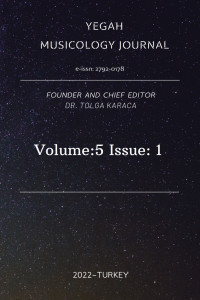SESSİZLİK VAR MIDIR?
Bu çalışma ile; “sessizlik var mıdır?” araştırma sorusu odağında, okuyucuların; bilimin amaçladığı gibi düşünmeye ve tartışma yapmaya dair aksiyon almalarını sağlamak amaçlanmaktadır. Bu amaçla yapılan çalışmada, argümanı yürütecek dökümanlar derlenmiştir.
Sesin ortaya çıkmasına neden olan ana olgunun titreşim olduğunu söylemek mümkündür. Ses, bir ajana ait atomların ileri ve geri hareket etmesiyle titreşerek enerji yaymasıyla üretilir. Bu titreşim, katalizörün etrafında bulunan hava, sıvı veya katı formdaki bir ortamı titreştirir ve hareket eden hava, yayılan enerjiyi her yöne taşır. Seslerin müzik tanımı içine girebilmesi; bir sese ilişkin uyumluluk ve anlamlılık algısı, içinde bulunulan topluma göre değişiklik gösterir. Duyulan seslerin müzik mi gürültü mü olduğu, toplum ve kültür bağlamındaki öznel algıdan ibarettir. Toplumların, genetik veya coğrafik bağlamda kendilerine tanıdık gelen sesleri uyumlu ve anlaşılır nitelendirerek müzik olarak algılamaları muhtemeldir.
Sesin algılanış biçimi; sesin özelliklerini oluşturan süre, yoğunluk ve frekans gibi değişkenleri ayırt etme yeteneğini içerir. Bu özellikler, bireylerin ya da toplumların sesleri yorumlama ve anlamlandırma becerisini geliştirir. Literatürdeki ilgili deneyde, sesin gaz, sıvı, katı gibi bir ortamdan geçen bir titreşim olması nedeniyle dünyada (laboratuvar kaynaklı vakum dışında) fiilen sessiz olan hiçbir yer olmadığı kanıtlanmıştır. Sessizlik olarak betimlediğimiz olgu, kulağımızla duyabildiğimiz ses aralığı dışında kalan seslerdir. Böylece; reel olarak, bugünkü teknolojik imkânlarımız ve beyin kapasitemizle sessizlik diye bir şey olmadığını söylemek mümkündür.
IS THERE SILENCE?
This paper focuses on the research question, "Is there silence?" and it is aimed to enable the readers to take action to think and discuss as science aims. This study has compiled documents that will carry out the argument.
It is possible to say that the main phenomenon that causes the emergence of sound is vibration. Sound is produced when the atoms of an agent vibrate back and forth, emitting energy. This vibration makes the air, liquid or solid form around the catalyst vibrate, and the moving air carries the emitted energy in all directions. Incorporating sounds into the definition of music; The perception of compatibility and meaningfulness of a sound varies according to the society in which one lives. Whether the sounds heard are music or noise consists of subjective perception in the context of society and culture. Societies likely perceive sounds that are familiar to them in a genetic or geographical context as music by qualifying them as harmonious and intelligible.
Perception of sound includes the ability to distinguish variables such as duration, intensity and frequency that make up the properties of sound. These features improve the ability of individuals or societies to interpret and make sense of sounds. In the relevant experiments in the literature, it has been proven that there is no place in the world that is actually quiet (except for a laboratory-induced vacuum) since sound is a vibration passing through a medium such as gas, liquid, solid. The phenomenon we describe as silence is the sounds that are outside the range of sounds we can hear with our ears. Like this; in real terms, it is possible to say that there is no such thing as silence with our current technological possibilities and brain capacity.
___
- BBC (2019). Silence programme. https://www.bbc.co.uk/programmes/m0002c8f Retrieved November 25, 2019.
- Bonard, J. M. (2000). The Physicist’s Guide to the Orchestra. arXiv:physics/0008053v1 [physics.ed-ph], Retrieved December 3, 2021.
- Cage, J. (1985). A Year From Monday. Morion Boyars Publishers.
- Driver, R., Squires, A., Rushworth, P., & Wood-Robinson, V. (1994). Making sense of secondary science: Research into children’s ideas. New York: Routledge Falmer.
- Encyclopedia Mypedia, Heibonsha Limited Publishers, Tokyo. [https://mimirbook.com/tr/43b9b714ccb]. Retrieved November 1, 2021.
- Erol, A. (2009). Thinking about music. Istanbul: Context Publications.
- Gfeller, K. (2016) Music-based training for pediatric CI recipients: A systematic analysis of published studies. Eur Ann Otorhinolaryngol Head Neck Dis. 133 Suppl 1 (Suppl 1):S50-S56. doi:10.1016/j.anorl.2016.01.010.
- Güler, Ç., & Çobanoğlu, Z. (1994). Noise. Ankara: Environmental Health Basic Resource Series No: 19.
- Hapkiewics, A. & Hapkiewics, W. (1993). Misconceptions in science. Paper presented at National Science Teachers Association regional meeting. Denver, CO.
- Holm, L. (2020). Does Silence Make-a Sound. https://owlcation.com/stem/Does-Silence-Make-a-Sound. Retrieved November 1, 2021.
- Parker, B. (2015). The Physics of Strong Vibrations Music. Ankara: Tubitak Popular Science Books 725.
- Silverman, K. (2012). Begin Again: A Biography of John Cage. Evanston, Illinois: Northwestern University Press.
- Tekin, V. (2020). Examination of live performances in the context of sound intensity and hearing disorders. Master Thesis, İnönü University, Institute of Social Sciences, Malatya.
- WHO (2021). World report on hearing. https://www.who.int/publications/i/item/world-report on-hearing. Retrieved October 25, 2021.
- Zeren, M. A. (1978). Sound systems in music, Ankara: Fotomat Publishing House.
